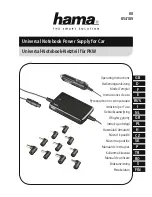
4. Place the
Dell Diagnostics Diskette
in the diskette drive and boot the computer.
NOTE: Before you read the rest of this chapter, you may want to start the Dell Diagnostics so you can
see the menus on your display.
When you start the diagnostics, the Dell logo screen appears, and a program tests the random-access
memory (RAM) that will be used by the diagnostics.
If a failure in RAM is detected, a message appears on the screen that tells you the memory address of the
defective memory module. Write down the memory address and see
for instructions on
obtaining technical assistance.
If no errors are found in RAM, the diagnostics loads and the
Diagnostics Menu
). The
menu allows you to exit to the MS-DOS
®
prompt.
Figure 1. Diagnostics Menu
For a quick check of your system, select the
Run Quick Tests
option. This option runs only the subtests that
do not require user interaction and that do not take a long time to run. Dell recommends that you choose this
option first to increase the odds of tracing the source of the problem quickly. For a complete check of your
system, select the
Run All Tests
option. To check a particular area of your system, select the
Run Specific
Tests
option.
How to Use the Dell Diagnostics
When you select
Run All Tests
or
Run Specific Tests
from the
Diagnostics Menu
, the main screen of the
diagnostics appears (see
). The main screen lists the diagnostic test groups, gives information about
the configuration of the computer, and allows you to select options from a menu.
To select an option from the
Diagnostics Menu
, highlight the option and press <Enter>, or press the key
that corresponds to the highlighted letter in the option.
Information on the main screen of the diagnostics is presented in the following five areas:
Содержание Latitude CPi A-Series
Страница 56: ...Back to Contents Page ...
















































